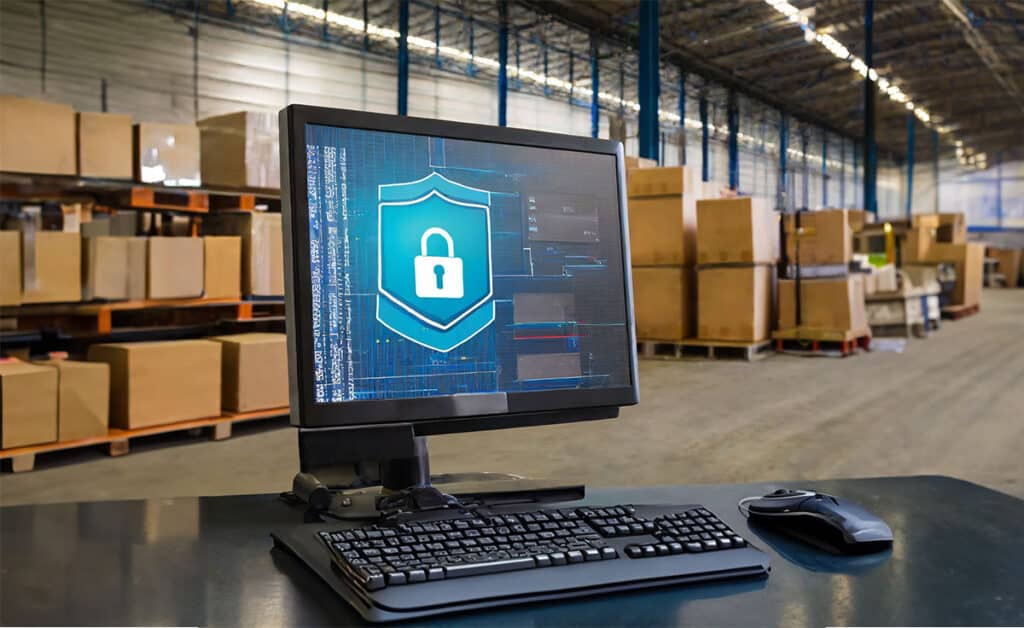 By Patrick Byers, DevOps Engineer, Lucas Systems
By Patrick Byers, DevOps Engineer, Lucas Systems
Following up on my previous post about critical elements to keep your warehouse and DC operations safe from cyberattack, it is important to have a robust incident response plan in place for your distribution operation in the event of a cybersecurity breach. This plan should outline specific steps to be taken in the event of a breach, including who to contact and how to contain and mitigate the damage. It should also include regular testing and updating
One of the most popular cybersecurity frameworks in use today is the National Institute of Standards and Technology (NIST) framework. This framework is widely used by U.S. companies, and it defines rules designed to help businesses achieve key cybersecurity goals. The NIST framework is broken down into five categories, each of which is designed to help businesses improve their cybersecurity posture.
Identify requires businesses to have processes in place that allow them to identify and understand their cybersecurity risks. This involves identifying the systems, assets, data, and capabilities that are critical to the business’s operations, as well as the threats and vulnerabilities that could affect them. This information is then used to develop a risk management strategy that takes into account the potential impact of different types of cybersecurity incidents. Specifically in the space of identification, here are 3 tactics to consider:
- Conduct a Risk Assessment: Conducting a risk assessment can help warehouse and DC operators identify vulnerabilities in their systems and processes. A risk assessment should evaluate the likelihood and impact of potential cybersecurity threats, including unauthorized access, data breaches, and ransomware attacks. This information can help operators prioritize their cybersecurity efforts and allocate resources accordingly.
- Review System Logs: Warehouse and DC operators should regularly review system logs to detect any unusual activity or potential cyber threats. By monitoring system logs, operators can identify potential breaches or unauthorized access attempts and take prompt action to mitigate the risk.
- Assess Third-Party Vendors: Warehouse and DC operators often work with third-party vendors for logistics and inventory management. These vendors can also introduce cybersecurity risks if they are not properly secured. Operators should assess the cybersecurity protocols and practices of their vendors to ensure that they meet their security standards.
Protect focuses on mitigating cybersecurity risks through a range of measures, including employee training, access controls, encryption, firewalls, and other security technologies. These measures are designed to prevent unauthorized access to critical systems and data, and to protect against malware, phishing attacks, and other common threats.
- Employee training is a crucial component of any cybersecurity strategy. Employees must be educated on the importance of strong passwords, phishing scams, and the potential risks of downloading malicious software. Regular training sessions can help ensure that staff members are aware of the latest cybersecurity threats and best practices for preventing them.
- Access controls are another essential element of a secure warehouse or distribution center. Limiting access to sensitive areas and data through user authentication and permission levels can prevent unauthorized individuals from accessing critical systems. Implementing a system of access control can also ensure that only authorized personnel can perform specific actions, such as adjusting inventory levels or modifying shipment details.
- Encryption is another effective tool for safeguarding data from potential cyberattacks. By encrypting sensitive information, such as customer data or financial records, warehouse and DC operators can ensure that even if data is compromised, it cannot be read or used by unauthorized individuals.
- Firewalls are also critical in preventing unauthorized access to warehouse and DC systems. A firewall acts as a barrier between a trusted internal network and untrusted external networks, blocking potential threats such as malware, viruses, or other malicious software from entering the system.
Other security technologies, such as intrusion detection systems, security cameras, and biometric scanners, can also enhance the security of a warehouse or distribution center. These technologies can help identify potential security breaches and prevent them from occurring, as well as provide a means of tracking and responding to incidents that do occur.
Detect recognizes that not all cybersecurity risks can be identified and mitigated in advance. For this reason, the NIST requires businesses to have ongoing efforts in place to detect active threats. This may involve the use of intrusion detection systems, network monitoring tools, and other technologies that can help identify potential threats as they emerge.
An intrusion detection system is a type of software or hardware that monitors network traffic and alerts the operator when it detects suspicious behavior. IDS can be classified into two types: host-based and network-based. Host-based IDS analyzes the activity on a single device, while network-based IDS monitors the traffic between multiple devices. IDS can detect various types of threats such as malware, unauthorized access, and denial-of-service attacks.
Network monitoring tools are also essential for detecting cybersecurity threats. These tools monitor network traffic and analyze it for suspicious behavior. They can identify abnormal activity, such as a large amount of data being sent from one device, or an unusual pattern of traffic. Network monitoring tools can also detect and alert the operator to potential cyberattacks.
Respond requires businesses to have a plan in place for responding to active cybersecurity threats. This may involve incident response teams, communication protocols, and other processes that are designed to contain and eliminate threats as quickly as possible.
The first step in building an effective response plan is to establish an incident response team (IRT). This team should include members from various departments, such as IT, security, operations, and management. Each team member should have clear responsibilities and protocols for reporting and responding to incidents.
Once the IRT is in place, the next step is to develop a communication protocol. This should include a clear chain of command for reporting and escalating incidents, as well as regular communication updates to all stakeholders. It is also essential to establish communication channels with external parties, such as law enforcement and regulatory bodies, to report incidents and seek assistance if necessary.
Another critical element of an effective response plan is to conduct regular cybersecurity awareness training for all employees. This should include training on identifying and reporting suspicious activities, password management, and other best practices for online security.
It is also important to conduct regular risk assessments to identify potential vulnerabilities in the system. Based on these assessments, the IRT can develop strategies to mitigate the identified risks.
Finally, it is crucial to have a backup and recovery plan in place. This should include regular backups of critical data and systems, as well as a plan for restoring operations in the event of a cybersecurity incident.
Recover focuses on the steps to take to recover from a cybersecurity incident. This may involve the timely restoration of systems or assets that have been affected by an incident, as well as improvements to processes and procedures based on lessons learned.
Warehouse and DC operators should conduct regular backups of critical systems and data to ensure that they can be quickly restored in the event of a cyber incident. Backups should be stored securely offsite, and tested regularly to ensure that they are functional. Conduct regular backups of critical data and systems, store backups off-site, and test backup and recovery procedures to ensure they work as intended.
Conduct a post-incident review to identify lessons learned and areas for improvement. This includes reviewing incident response procedures, identifying gaps in security controls, and implementing changes to prevent future incidents. Conduct regular vulnerability assessments to identify potential weaknesses in IT systems and processes. The post-incident review should be documented and shared with the response team and other stakeholders to ensure that everyone is aware of the lessons learned.
Test and validate your cybersecurity measures often
Having your cybersecurity posture tested and validated by an outside organization on a regular basis is an important part of an effective cybersecurity plan. Such testing can help identify vulnerabilities in your systems that may have been overlooked, and provide recommendations for improving your security posture. Additionally, it can help ensure that your organization is in compliance with regulatory requirements and industry standards. By working with an outside organization, you can benefit from their expertise and experience, gaining a fresh perspective on your security practices and procedures. Furthermore, regular testing and validation can help your organization stay ahead of emerging threats and ensure that your cybersecurity defenses are up-to-date and effective.
In conclusion, by taking proactive steps to protect their supply chains, warehouse and DC operators can ensure the integrity and resilience of operations in the face of increasing cyber threats. The NIST framework or any other proactive cybersecurity strategy is an essential tool for warehouse and DC operators looking to improve their cybersecurity posture. By following the rules outlined in the framework, businesses can identify and mitigate cybersecurity risks, detect active threats, respond quickly to incidents, and recover from cybersecurity incidents in a timely and effective manner. This can help protect against a range of threats and ensure that your warehouse or distribution center operations are able to continue effectively in an increasingly digital world.
 Patrick Byers leads internal automation and engineering processes at Lucas Systems, developing software-centered solutions that solve business problems for Lucas warehouse and DC customers throughout the world.
Patrick Byers leads internal automation and engineering processes at Lucas Systems, developing software-centered solutions that solve business problems for Lucas warehouse and DC customers throughout the world.
With a keen focus on improving end user quality of life and maximizing the warehouse floor workers’ experience, Patrick strives for continuous improvement in the processes and technology he oversees. Patrick is uniquely skilled in software development, automation, visualization, data organization, user experience and interface design.
He earned a Bachelor of Science degree in Information Sciences and Technology: Design and Development with a Minor in Security and Risk Analysis from Penn State University. He has also completed post graduate studies in software testing, programming practices, and development operations.





